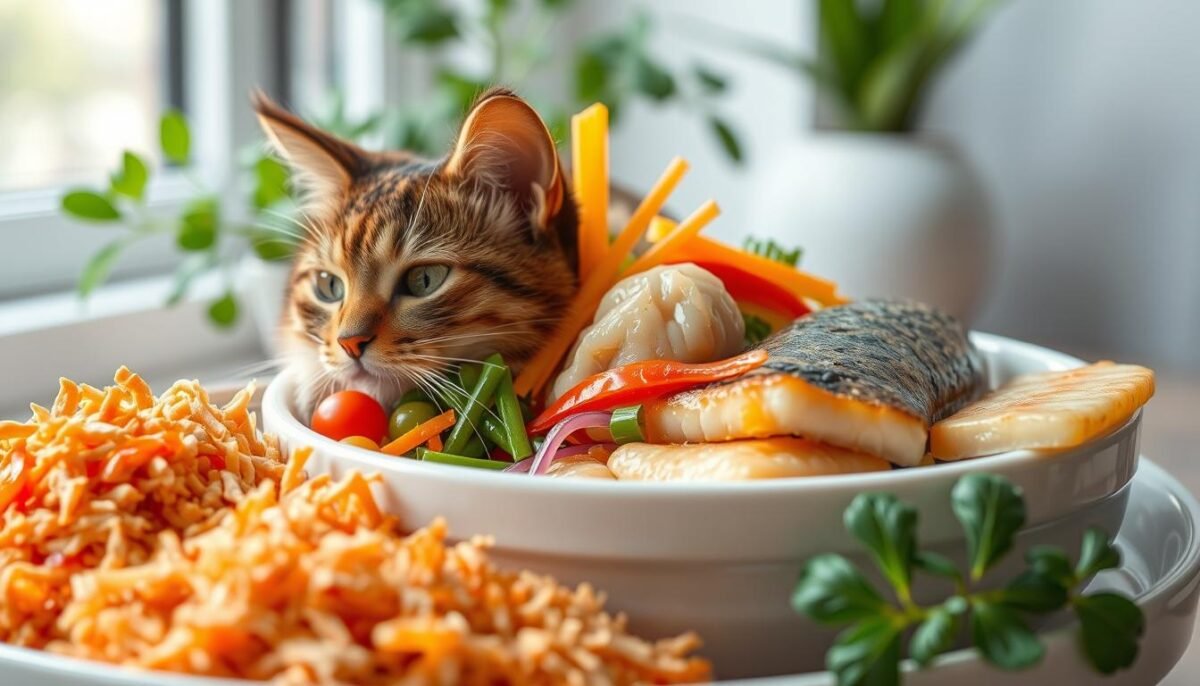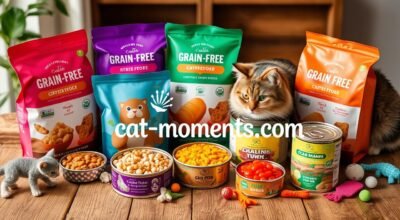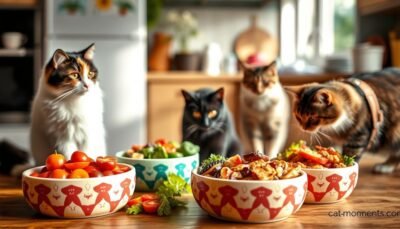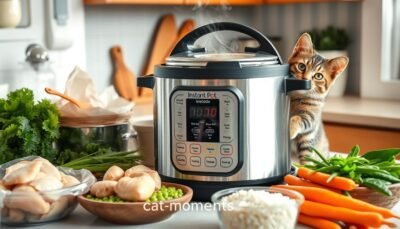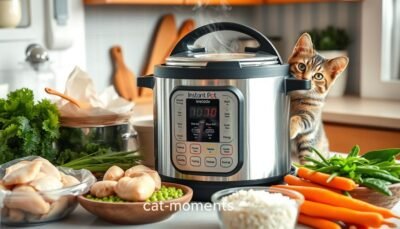Are you a cat parent looking to give your feline the best nutrition? Fresh cat food is the answer. This guide will cover the benefits, types, and what to consider when adding fresh, high-quality meals to your cat’s diet. Learn how fresh food can boost your pet’s health and happiness.
But first, let’s ask a question: Is your cat really thriving on kibble, or could fresh food make them even more vibrant? As pet parents, we must make choices that keep our cats healthy. Exploring fresh cat food might lead to better health for your feline friend.
Key Takeaways
- Fresh cat food offers superior nutrition compared to traditional kibble
- Cats may exhibit increased energy, improved digestion, and shinier coats on a fresh food diet
- Variety of fresh food options, including refrigerated, freeze-dried, and homemade
- Carefully selected ingredients, such as high-quality proteins and natural additives, are key
- Gradual transition and proper storage are essential for a successful switch to fresh cat food
What is Fresh Cat Food?
Fresh cat food is a new option for cat owners. It’s different from dry or canned food. Made from top-quality, whole foods, it’s processed less. This diet is like what wild cats eat, offering a mix of fresh cat food, natural cat meals, and raw cat diet.
Defining Fresh Cat Food
Fresh cat food uses unprocessed, whole foods. This includes meat, organs, bones, and a few plants. It’s cooked gently or kept raw. The big difference is it’s not made with the high heat and chemicals found in dry or canned food.
Benefits of Fresh Cat Food
- Improved digestion and nutrient absorption
- Healthier skin and coat
- Increased energy levels and vitality
- Reduced risk of obesity and other health issues
- More natural and species-appropriate diet
Feeding cats fresh cat food, natural cat meals, and raw cat diet helps them stay healthy. It supports their overall well-being and helps them thrive.
Why Choose Fresh Cat Food Over Kibble?
We want the best for our cats, and fresh cat food offers a great choice. It’s a new option compared to traditional kibble. Premium cat food brands are now available, giving us better choices for our cats’ diets. Let’s look at why fresh cat food is better than kibble.
Nutritional Advantages
Fresh cat food has more nutrients than kibble. Kibble is made by high-heat processing, which can lose nutrients. Fresh food keeps more of the natural vitamins and proteins cats need for health.
These grain-free cat nutrition options are made to match a cat’s natural diet. They provide a better diet for our feline friends.
Taste Preferences of Cats
Cats are picky eaters, and many prefer fresh food to kibble. Fresh food has natural flavors and smells that cats find more appealing. By choosing fresh cat food, we can make mealtime more enjoyable for them.
Switching to fresh cat food can greatly benefit our cats’ health. It gives them a more nutritious and tasty diet. This supports their health and meets their natural eating preferences. As pet owners, exploring grain-free cat nutrition options is a smart choice.
Types of Fresh Cat Food Available
Pet owners want the best for their cats, and there’s a wide range of fresh cat food out there. You can find everything from refrigerated to freeze-dried options, and even make your own. Let’s look at the different types of fresh cat food that can meet your cat’s specific needs.
Refrigerated Options
Refrigerated fresh cat food is a favorite because it keeps the natural taste and nutrients of real food. It’s made with top-quality proteins like chicken, turkey, or fish, and doesn’t have artificial preservatives. The cold storage keeps the natural cat meals fresh and full of flavor.
Freeze-Dried Choices
Freeze-dried fresh cat food is great because it’s like a raw cat diet but doesn’t need to be kept cold. It’s dried gently to keep the nutrients and taste in, making it easy to store and quick to rehydrate. This makes it a convenient choice for many.
Homemade Fresh Cat Food
If you want to control your cat’s diet, making your own fresh cat food is a good option. Using high-quality, human-grade ingredients, you can tailor the diet to your cat’s needs. This way, you can make sure your cat gets exactly what they need, tailored just for them.
Choosing the right fresh cat food is important, and it’s best to talk to your vet first. Each type has its own benefits, and what’s best for your cat will depend on their likes and your lifestyle.
Ingredients to Look for in Fresh Cat Food
Choosing the right fresh cat food is key for your cat’s health. Knowing the important ingredients helps pet owners make good choices. This ensures their cat stays healthy and happy. Let’s look at the main ingredients to find in premium natural and grain-free cat food.
High-Quality Proteins
Proteins are vital for a cat’s diet. They should come from animal sources like meat, poultry, or fish. Fresh premium cat food should list these as main ingredients. Avoid foods with lots of plant proteins or by-products, as cats need animal-based nutrition.
Natural Additives
Good cat food also has natural additives for health. These include:
- Healthy fats like omega-3 and omega-6 for skin and coat health
- Probiotics and prebiotics for better digestion and immune function
- Antioxidants to fight oxidative stress and boost immunity
Stay away from artificial preservatives, colors, or flavors. They can harm some cats.
Essential Nutrients
Good cat food should have all the vitamins and minerals cats need. Look for:
- Taurine for heart and vision health
- Calcium and phosphorus for strong bones and teeth
- Vitamin A for healthy skin and coat
- B-complex vitamins for energy and nervous system health
Choosing these essential ingredients ensures your cat gets the nutrition they need to thrive.
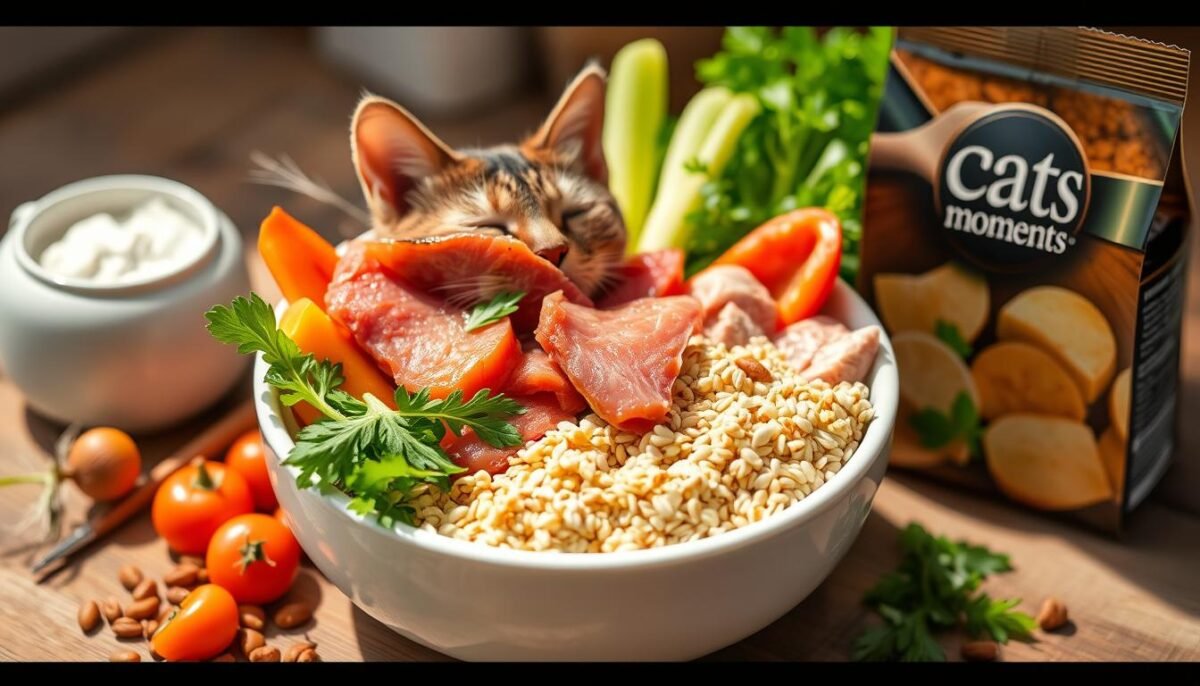
“Providing your cat with a fresh, high-quality diet is one of the best ways to support their overall health and well-being.”
Common Misconceptions About Fresh Cat Food
As more people choose fresh cat food, it’s key to clear up some myths. These myths might stop others from trying it. Let’s look at a few myths and share the good and bad of fresh cat food.
Fresh Food is Always Better
Fresh cat food has many benefits, but it’s not always the best choice. Some premium cat food can also give your cat all the nutrients they need. The important thing is to pick a high-quality food, whether it’s fresh or dry, that fits your cat’s diet.
Cost Considerations
- Many think fresh cat food costs more than regular kibble. But, the health benefits of fresh food can make it worth the extra cost.
- Think about the whole cost, including less vet bills and better health. Also, cats might eat less fresh food because it’s so nutritious, saving you money in the long run.
Choosing fresh cat food should be a thoughtful decision. Consider your cat’s needs, your budget, and the long-term health benefits. By clearing up these myths, we can help pet owners make better choices for their cats.
How to Transition Your Cat to Fresh Food
Switching your cat to fresh food is a rewarding journey. But, it’s key to do it slowly and carefully. By slowly introducing natural cat meals, your cat will get used to new tastes and textures. This makes the transition smooth and successful.
Gradual Introduction Techniques
Start by mixing a little fresh food with their old diet. Slowly add more fresh food over a week or two. This helps their stomach adjust, avoiding upset.
- Start with a 75% old food, 25% fresh food ratio.
- Gradually increase the fresh food portion by 10-15% each day.
- Offer the fresh natural cat meals at room temperature, as cats tend to prefer their food at a comfortable temperature.
Monitoring Your Cat’s Reaction
Keep a close eye on your cat during the transition. Watch their appetite, energy, and stool. Some cats might have softer stools as they get used to the new diet. If this happens, slow down the transition or add a probiotic to help their gut.
Every cat is different, and the transition time can vary. Be patient, consistent, and watch your cat’s needs closely. With a gentle approach and care for your cat’s health, you can switch them to a fresh diet that suits their natural needs.
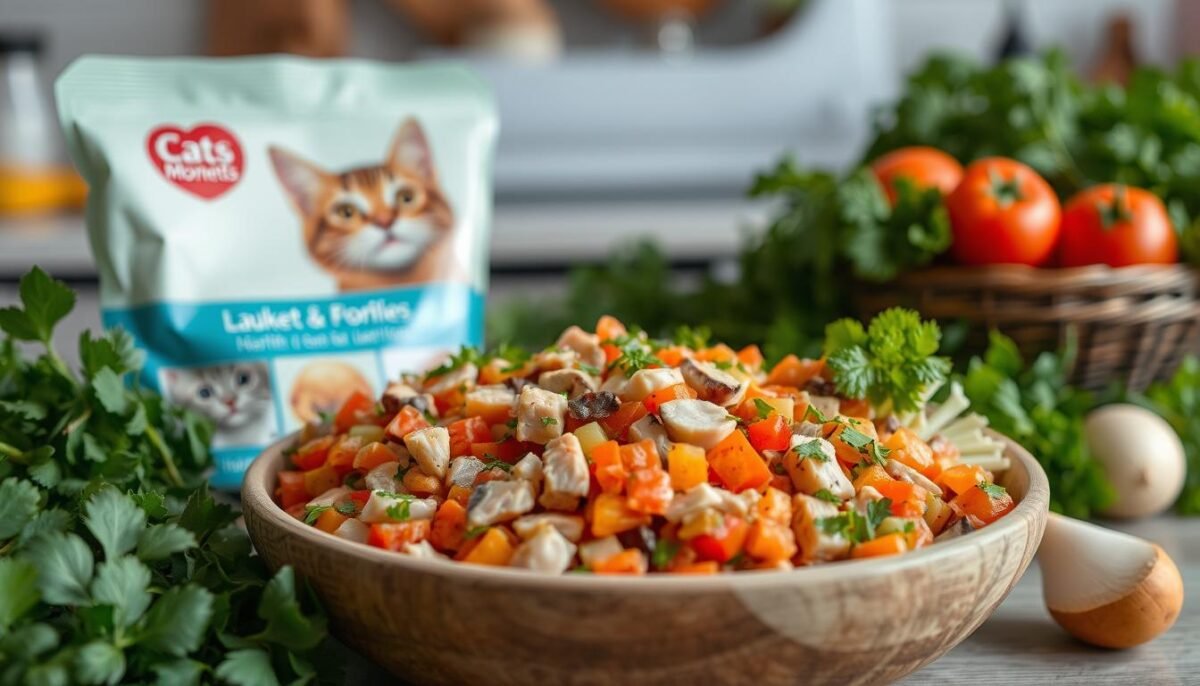
“Transitioning your cat to a fresh food diet takes time and patience, but the rewards are worth it. Your feline friend will thank you with improved health and vitality.”
Storing Fresh Cat Food Safely
Keeping your cat’s fresh food safe and fresh is very important. As pet owners, we need to store their food right. This ensures they get the best nutrition. Let’s look at how to store fresh cat food safely.
Best Practices for Refrigeration
Keeping food fresh in the fridge is crucial. Here are some tips:
- Use an airtight container or sealed bag to keep food fresh and prevent contamination.
- Put the container on the fridge’s bottom shelf. It’s cooler and more consistent there.
- Don’t open the fridge too often. It can change the temperature and spoil the food.
- Think about getting a pet food fridge. It keeps the temperature just right for food.
Handling Expiration Dates
It’s important to watch expiration dates for fresh cat food. Here’s what to do:
- Always check the expiration date before feeding your cat.
- Throw away expired food right away. It might have harmful bacteria.
- If you’re unsure about the food’s freshness or safety, don’t feed it to your cat.
- Buying smaller portions can help avoid waste and keep food fresh longer.
By following these tips, you can make sure your cat eats the safest and freshest food. Storing food properly is key to giving your cat the best fresh cat food and raw cat diet.
Understanding Fresh Cat Food Labels
Feeding our cats right means knowing what’s in their food. We need to check the labels for quality and health. This helps us pick the best food for our feline friends.
Reading Ingredient Lists
The ingredient list tells us a lot about the food. Look for premium cat food with animal proteins like chicken or fish first. Stay away from fillers like corn, wheat, or soy. They’re hard for cats to digest.
Also, check for natural additives. Vitamins, minerals, and antioxidants help keep your cat healthy.
What Certification Means
Certifications on labels show a food meets certain standards. For example, the USDA Organic seal means it’s organic. The Non-GMO Project Verified label means it’s free from GMOs. These labels reassure us we’re giving our cats the best.
| Certification | What It Means |
|---|---|
| USDA Organic | The food is made with certified organic ingredients, without the use of synthetic pesticides, fertilizers, or additives. |
| Non-GMO Project Verified | The food does not contain genetically modified organisms (GMOs). |
| AAFCO Approved | The food meets the nutritional standards set by the Association of American Feed Control Officials (AAFCO). |
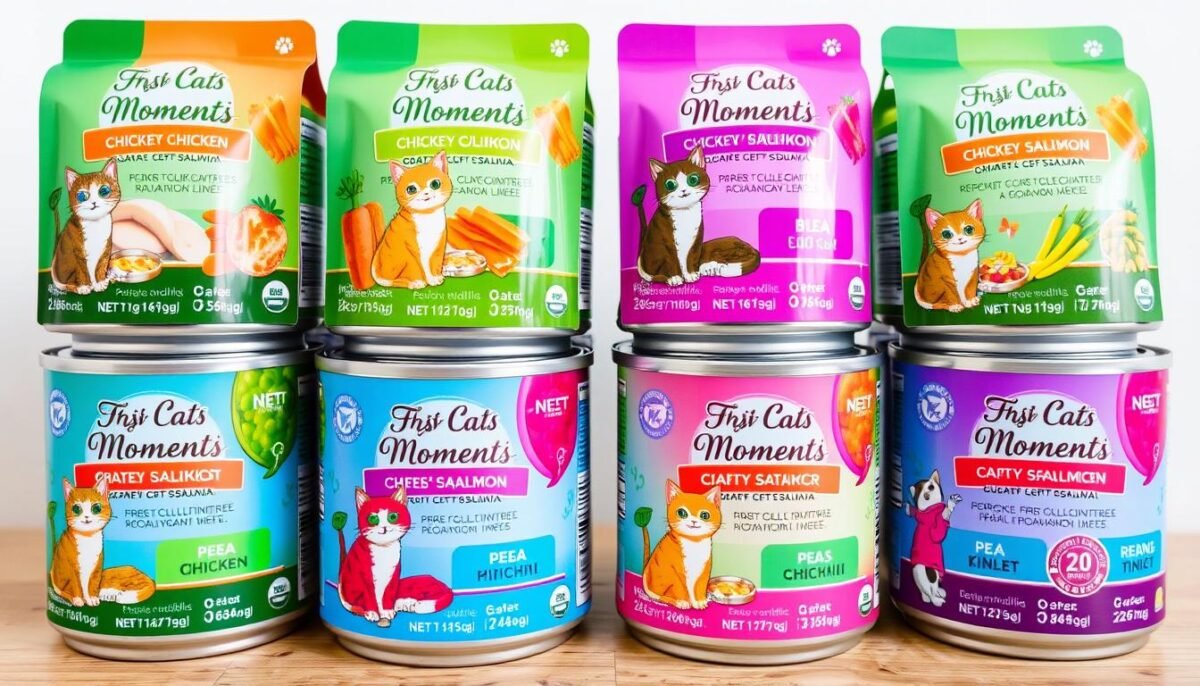
Understanding labels helps us choose the best food for our cats. This ensures they get the natural cat meals and grain-free cat nutrition they need to stay healthy and happy.
The Role of Fresh Cat Food in a Balanced Diet
Fresh cat food is vital for our cats’ health and happiness. As pet owners, we know a balanced diet is key. Fresh cat food, with its top-notch ingredients and lack of grains, is a big part of that.
Portion Control
Getting the right amount of food is crucial for our cats. Fresh cat food, being more moist and packed with nutrients, needs smaller portions. This helps avoid overfeeding and keeps our cats at a healthy weight.
Combining Fresh and Dry Food
Many of us mix fresh cat food with high-quality dry food. This mix offers the best of both worlds. It gives our cats the fresh food’s nutritional benefits and the dry food’s crunch.
| Feeding Approach | Advantages | Considerations |
|---|---|---|
| Fresh Cat Food Only |
|
|
| Combining Fresh and Dry |
|
|
Understanding fresh cat food’s role in a balanced diet is key. Whether we feed fresh food alone or mix it with dry, the goal is to watch portion sizes and meet our cat’s needs.
Where to Find Fresh Cat Food
Finding top-notch, fresh cat food is now easier than before. Pet owners have many options to get premium, natural meals for their cats. You can find it online, in local pet stores, or through subscription services.
Online Retailers
The internet has changed how we shop for our pets. Sites like Chewy and PetFlow have lots of fresh cat food brands. You can get food from Smalls, Instinct, and Stella & Chewy’s delivered to your door.
Local Pet Stores
If you like shopping in person, local pet stores are great. Places like PetSmart and Pet Supplies Plus have many fresh cat food options. The staff can help you pick the right food for your cat.
Subscription Services
Subscription services are also popular for fresh cat food. The Honest Kitchen and NomNomNow offer meal plans. They send high-quality, fresh food to your home regularly. It’s easy and saves you time and money.
FAQ
What is fresh cat food?
Fresh cat food is made from whole foods and is minimally processed. It’s designed to match a cat’s natural diet. This means it gives cats the nutrients they need to stay healthy.
What are the benefits of feeding my cat fresh food?
Fresh food can improve your cat’s digestion and coat health. It also boosts their energy and overall health. Plus, it’s closer to their natural diet, meeting their nutritional needs.
Why should I choose fresh cat food over kibble?
Fresh cat food has better nutrition than kibble. It uses higher-quality ingredients that fit a cat’s biological needs. Many cats also prefer its taste and texture over dry kibble.
What types of fresh cat food are available?
You can find refrigerated, freeze-dried, and homemade fresh cat food. Each type has its own benefits. Choose based on your cat’s taste and your lifestyle.
What ingredients should I look for in high-quality fresh cat food?
Look for high-quality proteins, natural additives, and essential nutrients. This includes meat-based proteins, healthy fats, and supplements like probiotics and vitamins.
Are there any misconceptions about fresh cat food?
Yes, some think fresh cat food is always better. Others believe it’s too expensive. But, it’s key to consider your cat’s needs and preferences.
How do I transition my cat to a fresh food diet?
Start by mixing new food with old food gradually. Slowly increase the fresh food ratio. Watch your cat’s reaction closely to ensure a smooth transition.
How do I properly store fresh cat food?
Keep fresh cat food at the right temperature and check expiration dates. This ensures your cat gets the best quality and nutrition.
How can I read and understand fresh cat food labels?
Check the ingredient list, certifications, and nutritional info on labels. This helps you choose a balanced diet for your cat.
How does fresh cat food fit into a balanced diet?
Fresh cat food is key to a balanced diet. Make sure to provide the right portions. You might mix fresh and dry food for a complete meal.
Where can I find fresh cat food?
You can buy fresh cat food online, at pet stores, or through subscription services. Research reputable brands to ensure your cat’s nutrition.
